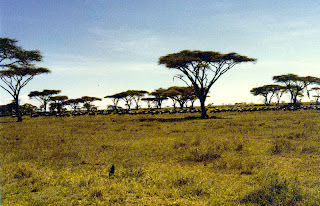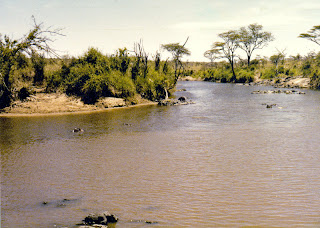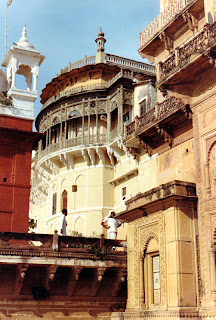On February 24th 1979 I was in Bodhgaya in India.
Bodhgaya was certainly the most important place in India for pilgrims and travellers interested in Buddhism. Being a small town in rural Bihar, it provided access to the countryside which was not often easy in India.
On this day I walked past the strange temple-like structure of the State Bank and sat in the afternoon for a couple of hours on a little mound, which looked as if archaeologists might have dug in it. This was therefore still in the town, overlooking some fields and the groups of houses behind the Burmese Vihar, where I was staying. I recorded what I saw in my notebook:
A woman in white and a boy with ochre cloth around his head usher two white cows and four buffaloes across fallow patches of grass. Earlier they had talked to their friends there, and mingled with a flock of goats which have now moved away. Beyond are little fields of something like wheat, very green, the boundaries marked by raised paths to hold in the water I'd guess. Beyond two boys work with willow baskets pulling some green plants, two goats feed, and beyond them three men or boys in shirts and grey short lungis seem to be planting. Then there is the row of brick houses, one or two storeys, occasionally painted. To the left near the path are more houses: I can see people walking, women with baskets on their heads, smoke rising, green things drying on the tiled roof of one. A little one room house is built away from the path into the field, the electric light already lit. Two women sit in front under a matting awning, two men under a palm-tree on a charpoy a little way away. Another house has fruit trees and dung drying on a wall; another further away is larger, has two bright red and green saris hanging drying from the roof. Bananas grow behind adobe walls and a dense line of palm-trees follows the angle of the path and the houses.
 |
| The State Bank: My picture taken in 1982 |
In front are ponds with some grey plants growing; within one pond a rubber water pipe runs partly across one edge. Paddy-birds sit here and only move white-winged to the edges when humans cross the green walls or other birds come too close. Further to the right behind the trees is another pond, drained and full of some pea-plant; here a crow-pheasant feeds, reddish wings and long black tail. The trees themselves are tall, sturdy and spreading, with long dark green leaves like mango-trees, wherein is a flock of red-vented bulbuls, mostly chattering. Behind to the left the sun is beginning to set, a pale white, still, winter sun above the hazy plain.
A group of smallish grey-black pigs has arrived, a sow in front of me with sagging belly and teats almost touching the ground, and a solitary roaming female dog. Little palm-trees rise eight feet high with little steps cut in, and a man has a pot hanging to collect the sap in. As evening comes the clamour around the houses rises, the birds begin to dash about in flocks overhead, the men come to relieve themselves in the open space behind, fires are lit. A man is cutting fish in one of the houses, the fish held in his foot. I can see a girl with two metal bowls on her head, a cow in a front-room byre, ducks in a pond.
I stayed at the Burmese Vihar, on the road to Gaya opposite the river. It was the cheap place to stay for most of the foreigners, pleasant and sociable, the two monks friendly, the rooms mainly shared and left unlocked. Upstairs was a library with a mixture of books, Indian and foreign, religious and secular, and I could always find something of interest. The Vihar was peaceful in the day, but not always at night because it backed onto houses which often had celebrations and music and generators going on in the night.
 |
| The Mahabodhi Temple: My picture |
The main focus of attention was the
Mahabodhi Temple, which is basically a stupa, with only a small sanctuary inside, but you could climb stairs and sit outside on a balcony. At the back was the Bodhi Tree itself spreading and shedding its characteristic leaves; it was not easy to sit under because it was such a centre of attraction. There were lots of other places to sit, by little shrines of one sort or another; there was also an adjoining garden around a tank which was peaceful if there were no groups of Hindu pilgrims visiting. Most visitors with an interest either sat and meditated in peaceful spots around the temple or circled the temple clockwise, either close to the building, or on the raised path which formed the limit of the site.
 |
| Shivanath: My picture taken in 1982 |
The main place for food and tea was Shivanath's. This was open long hours and served an almost unchanging menu of mixed vegetables with dhal and rice and the harder round breads called rotis. Shivanath's was a social centre as you could meet your friends at any time of day or evening and sit and talk on the open benches outside or in the closed room beside the kitchen. There was another place which did good puris and vegetables and there was Amala's, a Tibetan woman who did breakfasts at this time a little away from the centre of town. After a week or so some Tibetans set up tents and you could get chang in the evening there and perhaps some food. There was a simple bank and a little post office. There was a Tibetan temple which had rich paintings and a Japanese temple where a Zen priest held meditation sessions in the late afternoon and beat your back or knees with a stick if your concentration lapsed. There was a market which could get busy with people coming in from villages. There was a bathing ghat, but the river was almost dry in this season. The landowner, the Mohant, had a large house, the Math, between the town and the Burmese Vihar, with a temple inside and elephants kept in a tall byre near the river. There was a tiny island in the sandy expanses of the dried up river opposite the Math with a Shiva shrine which was occasionally visited by sadhus. This island was the most peaceful spot in Bodhgaya and I often liked to walk there in the heat of the day. I once sat there quietly and watched a small group of stone-curlews land and sit quietly observing me as I observed them.
Another time I wrote this in my notebook as I sat by the river a little along the road to Gaya:
Late afternoon in Bihar, the sun has lost its force, it's becoming white as it falls towards the trees. There is traffic returning to Gaya, a bus, a few tongas, an old man in white with spectacles and turban carrying a stick and a slight limp for his bare feet. A little fellow is cutting sap from the little palms that line the road. Kids play beneath the heavy mango trees between the road and the sand which forms the outside line of the river. In a green field on the other side of the road two men in white squat and watch the world go past, but there is little work in the fields at this time of year; the grain is short and green. A woman walks past slowly, she carries a little bottle with some liquid and a plant stopper, she has bare feet, a dirty white sari bordered in red and a goitrous lump hanging by her left ear. A boy carrying another boy on a bicycle shouts noisily at me. A buffalo stands at rest beside a building which carries an advertisement for fans, a run-down building with two doors and two windows, some grain piled up outside, some sort of wheel and old pieces of metal in a pile, white paint over bricks and a red tile roof, just a barn or maybe someone lives there.
I returned to Bodhgaya three years later, written up
here.
The Patrimonium Mundi
panoramas of Bodhgaya show that there have been a lot of developments around the Mahabodhi Temple since I was there.
 |
| At the Mahabodhi: My picture taken in 1982 |
 |
| The Island and The River: My picture taken in 1982 |











































